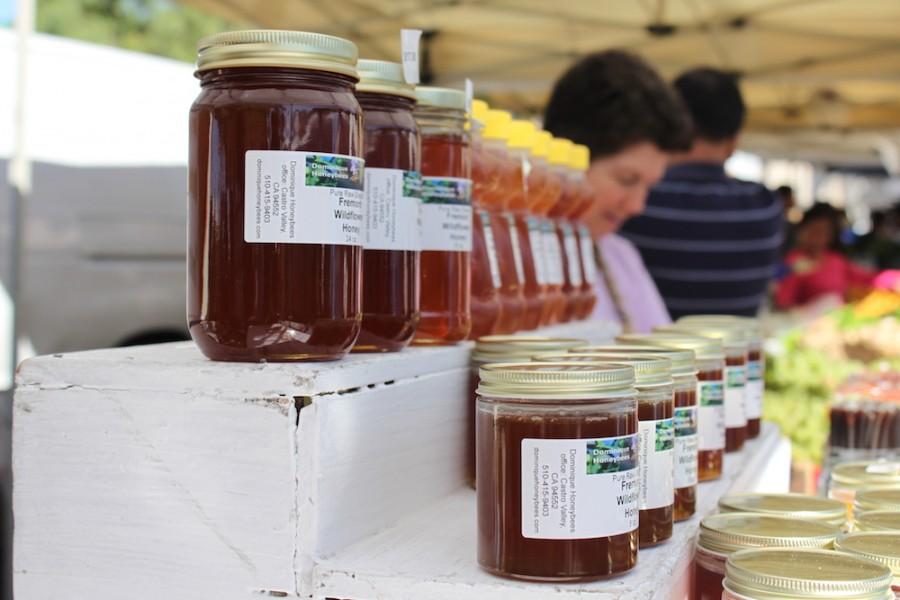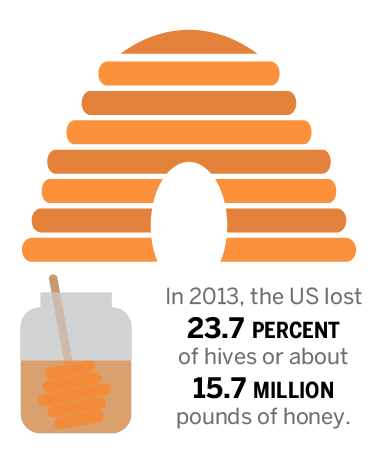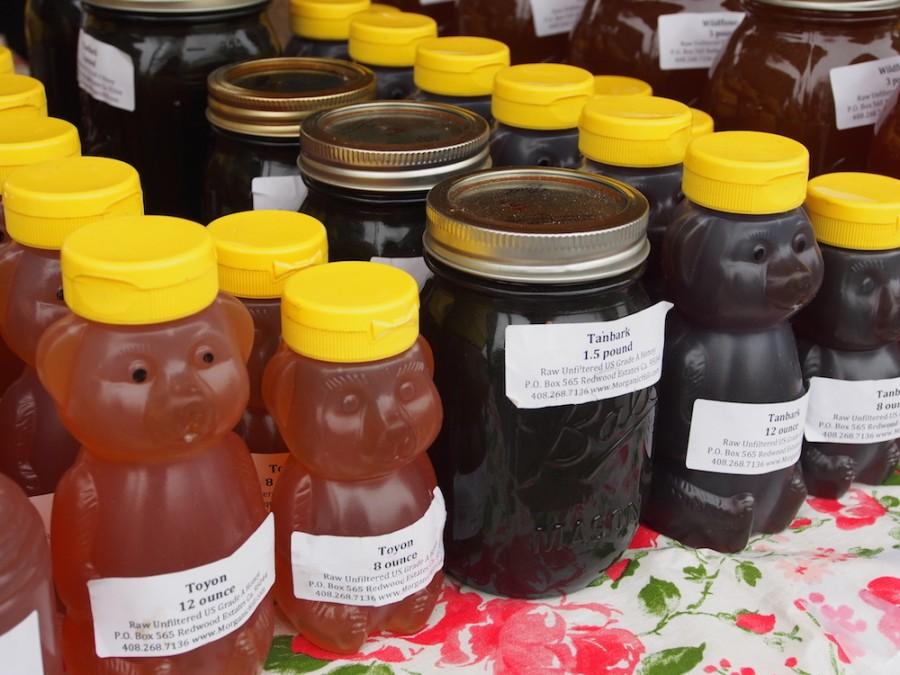Honeybee Catastrophe
Colony collapse disorder threatens hives, crops and the food we consume
October 18, 2015
Honeybee populations worldwide have been dying out in significant numbers for the past couple of years, leading to concern in agricultural and scientific communities.
According to the Bee Informed Partnership, an organization funded by the United States Department of Agriculture (USDA) and the National Institute of Food and Agriculture, California experienced 40.1 percent annual bee colony loss between 2014 and 2015. Some states, such as Illinois and Wisconsin, suffered as high as a 60 percent loss rate.
Prompted by stress, winter exposure or disease, entire colonies of honeybees will die out en masse due to Colony Collapse Disorder (CCD). Coined recently in a 2006 paper, CCD mandates meticulous attention from beekeepers to stabilize their bee populations.
“Nationwide we have usually about 30 percent winter kill of bee colonies,” Purdue Professor of Entomology Dr. Greg Hunt said in a phone interview. “The beekeepers have to scramble to make up these losses, raise new queens, split their hives, make new hives, and that’s why we still have bees.”
In our ecosystem, the worker honeybees play the critical role of pollinators as their numbers eclipse those of any other potential candidates.
“There’s a number of major crops quite dependent on honeybees as the pollinators,” biology teacher Dr. Gary Blickenstaff said. “If we don’t have them, you won’t have those crops.”
This includes many cultivated plants – apples, coffee, tomatoes, rapeseed (Canola oil plant), carrots, strawberries, alfalfa and most tree nuts are just a few of the plants that are exclusively pollinated by bees.

“Go around to the Central Valley, where they have all these orchards, and what you’re going to see in the Springtime is hundreds of boxes of beehives placed out in the orchards simply because [farmers] need them to pollinate those trees,” Dr. Blickenstaff said.
According to the USDA Agricultural Research Service, honeybees increase crop value by more than $15 billion every year. According to the California Department of Food and Agriculture, almond trees produced $5.8 billion worth of nuts in 2013.
Honeybees are also nearly exclusive pollinators for the flowers of many wild plant species. Loss of biodiversity resulting from a decline in honeybees reduces the gene pool for potential new strains of crops.
While other pollinators do exist, they are either not suited to the terrain of agricultural areas or too few in number to be effective.
“Are you going to train moths to [pollinate crops]?” Dr. Blickenstaff jokingly said. “It’s not going to happen.”
Bees’ death linked to parasites, pesticides

Honeybees are beleaguered by a number of often lethal diseases, many of which do not have an obvious solution.
The most common of apian diseases is infestation by varroa mites, which are an obligate parasite to the honeybees. Two species of mites, Varroa destructor and Varroa jacobsoni, act like mosquitoes – they penetrate the bees’ exoskeletons to suck their hemolymph, the “blood” of invertebrates, leaving open wounds that make bees vulnerable to infection. In addition, varroa mites are themselves carriers of a virus that causes developmental wing deformities in honeybee larvae, crippling bee populations.
“Our only way to combat this is to lower the number of mites in a colony,” local beekeeper at Dominique Honeybees, Judy Casale, said. “We try to use organic approaches that will kill the mites without hurting the bees. And that’s the hard part – killing a bug on a bug without killing both bugs.”
There is no ready cure for varroa mites. While treatments do exist, they are not completely effective, and the remaining mites become selectively resistant to cures.
“The problem with mites is, we never completely get rid of them,” Dr. Hunt said. “In addition, when colonies collapse from [varroa mites], other bees rob the honey from the colony and pick up mites.”
While this problem is prolific, surprisingly few beekeepers take action against it. According to a 2015 “Varroa Summit” report by the United States Department of Agriculture’s Agricultural Research Service, 59 percent of beekeepers who responded to a national survey reported the presence of varroa mites, yet did not treat them.
Dr. Hunt has been working on a unique solution to help colonies resist infestation from mites in a sustainable way.
“At Purdue, we’re breeding for bees that groom mites off of themselves and bite mites,” Dr. Hunt said.
These “Indiana mite-biter” queens have been selectively bred to create bee colonies that instinctually remove mites.
“We started in 2007 and had an average of three percent chewed mites in our top breeding population. Now we’re up to about almost 50 percent,” Dr. Hunt said. “We also did a community beekeeper volunteer experiment, where we gave beekeepers queens from commercial queen breeders, or from Purdue stock. They didn’t know which was which. After over a year of this, 44 percent of the Purdue queens died compared to 78 percent of the commercial colonies.”

Efforts like Dr. Hunt’s may be employed to help mitigate the effects of varroa mites on commercial colonies in the near future.
Another common apian disease is a bacterial infection called foulbrood, which comes in American and European strains. Foulbrood infects bee larvae, killing them while still in development. Foulbrood continues to grow in the corpses of the larvae, creating millions of bacterial spores that spread the disease.
When worker bees clean up the hive and remove the dead larvae, they catch these spores, which contaminate the hive’s food supply. These spores are resistant to destruction, remain viable for up to 40 years and can only be effectively destroyed by burning the infected hive.
One potential factor in CCD that is only recently beginning to be investigated is the use of artificial pesticides containing neonicotinoids, which have been linked to bee deaths.
Neonicotinoids are water-soluble insecticides similar to nicotine, the active ingredient in tobacco. Because of neonicotinoids’ relatively long shelf life (decomposition takes around 3.8 years in the absence of sunlight), the chemical can accumulate in the environment and poison bees even without direct application. Hampering honeybees’ ability to detect nectar, navigate and remember feeding locations, neonicotinoids can severely reduce a colony’s ability to feed its workers and larvae.
Response to these studies has been mixed. In 2013, the European Union motioned to restrict the usage of these pesticides for three years. America has not written any legislature against pesticides, although some activists have called for action.
While the decline of honeybee populations continue, governmental authorities and scientists are working to combat it.
“It’s a struggle this year, and the drought has certainly affected things, and colony collapse has affected things,” Casale said. “But the one good thing is that it’s getting interest from the public and government groups to research.”

